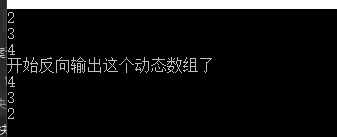67)vector的begin() end() 和 front() back()的区别 rbegin() rend()
1)
··············
2)`````````v1.begin() 和v1.end() 是作为迭代器v1的 第一个位置 和 最后一个元素的下一个位置。
`````````````v1.front() 是v1这个动态数组的第一个元素的值
············ v1.back()是v1的最后一个元素的值。
3)

4)正向和反向的使用rbegin和begin()
1 #include<iostream> 2 #include<vector> 3 4 using namespace std; 5 void hanshu() 6 { 7 vector<int> v1; 8 v1.push_back(2); 9 v1.push_back(3); 10 v1.push_back(4); 11 //正向遍历 12 for(vector<int>::iterator it=v1.begin();it!=v1.end();it++) 13 { 14 cout<<*it<<endl; 15 } 16 cout<<"开始反向输出这个动态数组了"<<endl; 17 //反向遍历 18 for(vector<int>::reverse_iterator rit=v1.rbegin();rit!=v1.rend();rit++) 19 { 20 cout<<*rit<<endl; 21 } 22 23 24 } 25 int main() 26 { 27 hanshu(); 28 return 0; 29 }
结果展示:




